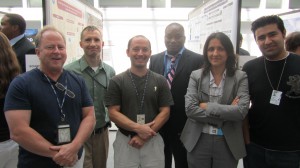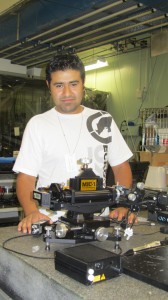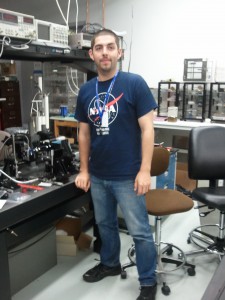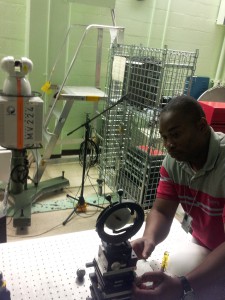NASA GSFC 2012 Summer Internship
The Remote Sensing students involved in research at NYCCT/CUNY continued their research at NASA Goddard Space Flight Center during the 2012 Summer. By clicking on the picture below you can see and hear the students and faculty talking about their experience at NASA GSFC.

- The NYCCT team formed of Prof Viviana Vladutescu and ETET students Edwin Olaya and Agossa Segla presenting the work conducted at NASA GSFC, alongside their mentors Dr. Raymond Ohl, and Phillip Coulter in the Instruments and Technology Division, Optics Branch (NASA GSFC 5510)
The summer work within the AETD Instruments and Technology Division, Optics Branch (NASA GSFC 5510) involved the development of optical metrological procedures for optical integration, alignment, and test of the James Webb Space Telescope’s (JWST) Integrated Science Instrument Module (ISIM). Hubble successor, the James Webb Space Telescope (JWST) is an infrared-optimized space telescope to be launched in 2018. The goal of JWST is to see first galaxies that formed in the early Universe, connecting the Big Bang to our own Milky Way Galaxy. Here is a short movie about JWST.
In the first project, the students’ (Edwin Olaya and Agossa Segla) and faculty’s (Dr. Viviana Vladutescu) goal was to calibrate a CCD Detector array such that each pixel is mapped into the coordinate system used by JWST at ambient. This procedure ensures proper alignment of the optical telescope with the space instrument sensor. This was done by verifying the relative positions of the PAR (Pupil Alignment Reference) at the entrance pupil with respect to the exit pupil. The instruments and software used in this non contact measurement procedure were the Laser Unequal Path Interferometer, the laser radar, Spatial Analyzer and MATLAB. Before any procedures were conducted a calibration of the LUPI interferometer was conducted. This calibration was performed successfully by validation against an existing calibrated LUPI. In addition to this project the NYCCT team developed procedures to characterize uncertainties in scanned objects with a smooth blanket, wrinkle blanket and without the blanket by using the Laser Radar (LADAR) and the software Spatial Analyzer. The LADAR was also used to measure the surface of optical elements (i.e. gold concave mirror, flat mirror etc) with a high accuracy.

ETET student Edwin Olaya working with the LUPI(Length Unequal Path Interferometer) in the Optics Branch of the Instruments and Technology Division at NASA GSFC.
ETET students, Edwin Olaya and Agossa Segla working on non-contact measurements of large format detectors and thermal blanket material surrounding the flight instruments of JWST. Their presentations can be accessed here:
Poster_NASA_Edwin and Agossa_Nasa_PPT

Student Antonio Aguirre designing nano waveguides along scientists in the NASA Lunar and Planetary Science Division
ETET student Antonio Aguirre, worked in the Lunar and Planetary Science Division of NASA GSFC suring the 2012 Summer Internship. In his research a Fourier transform spectrometer has been developed using an ensemble of rectangular waveguides in a Mach-Zehnder configuration. Each waveguide channel has dimensions (10 – 100 μm) – on the scale of the operating wavelength (10 μm). Currently, spectrometers for planetary exploration are bulky, expensive, and take a significant amount of time to fabricate. The proposed method for spectroscopy bares the possibility of reducing the cost, size, and fabrication time. Specifically, the immediate tasks involved measuring the transmission efficiency of the waveguide structures, improving micro-electromechanical systems (MEMS) fabrication techniques, and controlling the desired propagation mode. Tony’s presentation can be accessed here:
AAguirre_Summer 2012_NASA_GSFC_Poster




